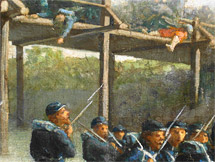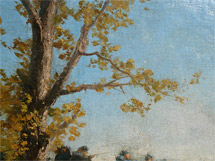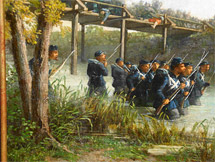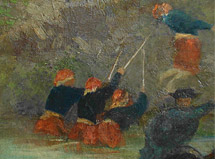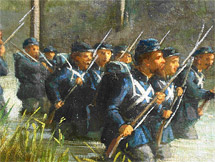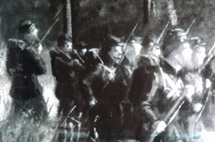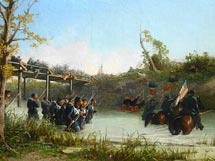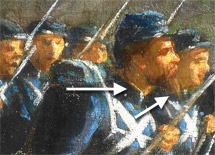Manner & Technique: Details of Homer's Manner of Painting

Kristin Hoermann, in her 1988 article, âA Hand Formed to Use the Brushâ describes in scholarly detail the many techniques and characteristics of Homerâs painting style (3.8). Seventeen separate techniques can be found in Watching the Shot that conform to Hoermannâs research of Homerâs Civil War painting processes and procedures.
- ⌠exhibiting the subtle understanding and careful control of color and space characteristic of Homerâs work throughout the Civil War period (3.9).
Show/Hide DetailsIn Watching the Shot Homer has tied all of the elements together in a very illustrative fashionâsomething he was trained to do as an illustrator. Depth perception is executed with the diagonal line of the bridge. The bridge as well traps our attention back to the foreground. An early afternoon blue sky coming from our right is in contrast to the battle below. Rising white smoke from the battle fills the air across the bridge complementing the vivid blue sky. The tree to the left forces us back into the action. The soldier just coming from behind the tree, causes us to follow his intended path toward the main subject of the painting, the lone soldier who watches the shot. The lone soldier is subtly framed by the angled downward pointing from the bridge of a dangling dead soldierâs arm, along with the red pant leg of an also deceased Zoavue soldier leg pointing at the same angle (Fig. 3-2). The use of space is controlled by the perspective from which the artist is painting the image, from the near bank and suspended slightly in air, but not as high as the bridge. This interesting perspective allows us to view the entire battle scene watching the shot and observing the watcher at the same moment in time. This is an extremely well thought out painting, and masterfully illustrated, leaving the viewer with the sense of onsite observation. -
The unleashing of bold color in the smallest spots, while the general color scheme is kept carefully under control, is characteristic of Homerâs technique throughout these early pictures (3.10).
Show/Hide DetailsThe red of the Zouave pants climbing the far bank, the two flags and the dead Zouave pant legs on the bridge provide the limited bold color visible, and yet carefully balanced throughout the painting. The use of red pigments in subtle dabs here and there, seem to be typical of Homerâs early works. Although less noticeable to the naked eye are very small dabs of bright yellow in the leaves on the tree to the left (Fig. 3-3). The foreground also contains small splashes of color, mostly in dabs of dulled orange and occasional bright yellow and green streaks of paint representing marsh reeds and other vegetation. - The device of engaging the viewer through forms severed at the picture edge is used repeatedly in the paintings ⌠(3.11).
Show/Hide DetailsBoth the large tree to the left and the bridge accomplish this artistic tactic for Homer. On the right side of the painting, the path up the embankment, where the soldiers in the water seem to be heading toward, is also cut off from our view near the top of the ridge. The sunlit empty path in turn points the viewerâs eye back down the embankment to the water and cavalry horses, reengaging us in the overall scene. - The dominant tonality of most of Homerâs Civil War paintings is based on the complementary colors of orange and blue (3.12).
Show/Hide DetailsThe brightest orange coloring is in the subtly varying orange tones found in the leaves of the large tree to the left. The orange pigments are set directly against the light blue of the sky (Fig. 3-2 in section 2 above). There are also tinges of orange at the top edge of the bushes and trees on the far embankment, again against the blue of the sky. Of significance is the overall tonality of the faces and hands of the soldiers crossing the river, they are strongly orange toned and compliment the dark blues of the soldiersâ uniforms (Fig. 3-4). - Neither was Homer deeply concerned with traditional and current painting practice. His use of color was bold for his time, and frequently not accepted by the critics:
- The figures are full of character, but a trifle fresh in color, as is also the landscape.
- They are not pleasing in color, but in many respects very creditable and promising.
- They are crude in color, and not altogether correct in drawing; but they show great originality âŚ
- The color is a trifle crude ⌠(3.13).
The sky in Watching the Shot is Robinâs egg blue, the leaves of the tree very bright in orange hues and dabs of bright sun yellow, the faces unnaturally orange and the color red is scattered throughout the painting, while the rest of the scene could be considered darkly painted. The Zouave pants are not just red, they are unblended pigments of orange, yellow, and peach along with red (Fig. 3-5). That Homer did not blend the edges of pigments, as already discussed, also explains the almost impressionistic look of this painting, and most of his other Civil War works of art. What strikes most viewers first about Watching the Shot is the intensity of the looks on the soldiers walking in the water. This is not a heroic theme, nor is it subtle posing of characters, it tells a story not common to most other painterâs art work of the time. Watching the Shot embodies what made Homer unique in his time, figures full of character, open brushwork and colors (according to critics of his time) not pleasing. - One of the distinctive aspects of Homerâs technique is his use of flat tonesâ unmodulated areas of color juxtaposed to flat dark shadows, without blending them together into a smoothly modeled form (3.14). This smoothing and refining is referred to as âfinish,â and it was the lack of finish that disturbed many of Homerâs critics, from the 1860s onward (3.15).
Show/Hide DetailsThis point has already been touched upon in previous observations. The soldiers' sleeves show unblended colors of emerald green and light blue next to a violet hue on the dark indigo blue uniform (Fig. 3-6). The Zoauve uniforms and hats consist of unblended pigments of orange, red, peach and yellow. Similar examples of unblended paintâs, are found throughout the painting, such as the toned down white and lighter browns on the horses rumps, to show the reflection of sun light. And a very typical Homer technique found throughout his long career, that of dabs of washed white, washed yellow or washed green over the darker leaves of trees and bushes, as seen in the extreme lower left of the image as well as down river and below the bridge. This trademark Homer style of painting leaves gives the impression of light shining from behind and through the leaves as reflected light. - Commenting on Homerâs use of Chevereulâs book Hoermann reports: Indeed, in his copy of Chevereul, under the heading âModifications produced by Yellow light,â Homer has marked the lines âYellow rays falling on Light Blue make it appear Yellow-green.â And âYellow rays falling on Dark Blue make it appear Green-slateâ (3.16).
Show/Hide DetailsThe use of this latter technique can be clearly seen in the uniform of the last soldier in the troop crossing the river (just before our lone soldier) as his uniform is a slate green color. Why Homer depicted only this one soldierâs uniform to reflect the early afternoon rays of light in such a way is unknown; that he has is significant. The light reflecting off the water has also caused Homer to paint the trousers of the wading men a gray-green color. Homer uses white paint applied directly to the canvas to show light reflecting on metal, i.e. swords and rifle bayonets; another Cheveruel concept. - It is tempting to suppose that many of the foreground figures may have been painted more directly with the aid of lay figures and live models (3.17).
Show/Hide DetailsThis statement suggests that Homer used a variety of sources for the figures in his paintings. X-radiographic imagery tells us that the General leading the soldiers across the river, now somewhat faded, was painted on top of the painting after completion, and so may have been from a sketch. This figure has little characterization evident and serves only as a prop in the story Homer is telling. The General is not part of the under drawing. However, the infantrymen crossing the water are more modeled and appear to be painted from live models, especially given their serious and worried looks. The lone soldier may have been drawn from a mannequin Homer kept in his studio, dressed with a uniform, but the face strongly suggests a live model (Fig. 3-7). X-Radiographic images and infrared imaging both show that all of the soldiers walking in the river are part of the original under drawings. (See "Scientific Evidence"). - The spatial construction in Homerâs paintings is very carefully controlled. Separate compositional units are placed in separate planes stepped back into space (3.18).
Show/Hide DetailsWatching the Shot has a lively and colorful foreground of vegetation, leading into the river. The river and the soldiers in the river are divided into two groups, representing only slightly different distances. This slight variation in depth (distance away) for the group consisting of the leader and cavalry soldiers is clearly aided by the open space placed between the leaders and the infantry men. Although they rest on the same plane on the canvas the space between them creates the illusion of depth and distance. The water is seen to foam and leave a small wake as it passes around the horseâs legs. But on the far side of the river, the water reveals no such disturbances, but does now reflect the red of the Zouaveâs pants in the water near them. Subtle impressions like these entice the viewer to believe the illusion of distance. The diagonally placed bridge on the canvas also utilized part of the middle distance and transitions to the background, which remains active as seen by the clouds of smoke and mass of huddled bodies on the bridge. It is the background which contributes powerfully to Homerâs telling of the Zouave soldier being shot, adding a sense of realism to the entire scene. This is why, as previously stated, the artist perspective is slightly elevated so that we can all watch the stageâalbeit the stage of war. - Homer was very skillful at creating the illusion of depth in his painting. A decrease in size is the simplest technique. He used a tiered diminution in size for background elements, rather than a truly consistent reduction with distance, and this exaggerates the sense of space considerably (3.19).
Show/Hide DetailsHomer employees many of the professional illustratorsâ tools in this painting. The bridge naturally decreases in size as it spans from middle ground to background, which adds substantially to the perspective of depth in the image. In the background the Confederate flag is seen, as is the shooter and the Zouaves clambering up the bank all in extremely reduced sizes compared to the soldiers in the foreground. The distance perception is aided by the blurring of these distant soldiers, with the sniper appearing fuzzy, as he might appear from a fair distance. In the foreground, the infantry man closest to the viewer is half again as big as the soldier on the other end of his front row, just two soldiers away. Homer has designed the groups of soldiers to diminish in size and clarity employing a meandering âSâ transition movement. As an observer our eye follows the soldierâs path through the water, traveling from left to right we are led to the cavalry men on their horses, they are staggered and diminish slightly in size and our eye is now led back left again and deeper into the river until the Zouave soldiers are found at the base of the far bank. Completing the âSâ pattern our eye follows up the embankment where we find the shot Zouave soldier. Utilizing this âSâ layout and combined with size reduction and image distortion, the illusion of distance and depth is masterfully crafted (Fig. 3-8). - Homer made frequent use of the perceptually more natural principle of aerial perspective, whereby objects in the distance appear closer in value to each other than objects in the foreground, and do not exhibit the same extremes of dark and light (3.20).
Show/Hide DetailsAs previously discussed the entire battle scene is seen from a slightly elevated perspective giving the sense that it was executed on location and at the time of the battle. Of course, it was not likely created on location, although there may be field sketches relating to this work. It probably was not even observed by Homer, but is most likely his interpretation of a battle scene, or several battles, described to him by participants of such a battle. The point of view of the artist is key to telling the tale in Watching the Shot. As well is the perceptual reality of the shooter appearing fuzzy and is bluer than his true uniform color of butternut gray would actually be, while all other rebels in the background fade into monotone browns and grays. The overall tonal value of colors in the background, coalesce as they reach the distant Confederate flag. - The steps in Homerâs painting process remained fairly constant throughout these pictures. He used a medium-fine pre-primed canvas ⌠Homer drew the separate design elements onto the canvas or wood support with pencil and sometimes chalk. He included in the under drawing foreground, middle ground, and distant compositional units, as well as the horizon line and major landscape elements such as trees, arbors, and embankments. No traces of under drawing are found for many of the foreground still-life elements (3.21).
Show/Hide DetailsX-Radiographic images show that there are no under drawing for the foreground, it was painted free hand at the end of the painting process. With only a few exceptions, all other elements contained in the painting, from bridge, combatants, embankment, shooter, Zouaves, soldiers, left severed tree, as well as the bushes and severely damaged tree on the far bank have all been drawn in with pencil prior to beginning to put pigment on this medium-fine pre-primed canvas. - With the composition thus defined, Homer began the actual painting. He seems to have completed areas in a piecemeal fashion. One of the first elements he painted was the sky, perhaps because it gave him an overall sense of the light that would illuminate the picture. âI have learned two or three things in my years of experience,â Homer told Beatty in 1903. âOne is, never paint a blue sky.â When asked why, he replied, âWhy, because it looks like the devil, thatâs all. Another thing; a horizon is horribleâthat straight line!" (3.22)
Show/Hide DetailsIn Watching the Shot the sky is Robinâs egg blue, although it fades to the right to a much quieter tone. The source of the light is overhead and slightly from the west (right). Homerâs aversion to an all blue sky line is muted in the battle scene by the early afternoon light fading the blue of the sky, as well by the rising thickness of gun powder smoke covering nearly one quarter of the entire skyline. The sky line is further agitated by the extension of the severed tree on the left and the extremely damaged tree in the background. The horizon lines of the Civil War pictures are varied by silhouetted trees, pine branches, stumps, horses or tents, and often by a jumping rhythmically angular band that energizes the painting (3.23). Watching the Shotâs horizon is broken by the insertion of natural elements, trees, bushes, and the unnatural smoke of war. Homer also blocked in the sky with a pale blue wash. The skies in other pictures could be similarly under-painted, masked by the thick paint on top (3.24). The sky in Watching the Shot is painted very thickly. - The order in which the other elements in each picture were painted is difficult to determine. It can only be judged when the edges of one form overlap another area. For instance, it can be seen that Homer invariably painted the uniforms before faces and hands (3.25).
Show/Hide DetailsIn Watching the Shot there remain several examples where the paint of the faces of the soldiers over lap uniforms. In one close up photo it can be seen where the neck of the face overlaps the uniform clearly demonstrating that the uniform was painted first. Often the soldierâs hands can be seen to overlap the uniform, yet never do the uniforms overlap the hands, demonstrating again that the uniform was painted first (Fig. 3-9). - The foregrounds of these pictures are very dynamic and eye-catching. Homer dashes off streaks of color that energize the foreground and invite the eye into the picture (3.26).
Show/Hide DetailsThe foreground of the battle scene has been smattered with long and short strokes of color, mostly in un-modulated greens and yellows, and highlights of unblended white to suggest reflecting light. Many of the patches of paint are very broad showing great confidence in the boldness of setting down a color without blending. It is a very lively foreground used both to block out the waters edge, as well as to invite the eye into the water and the scene. - In many of his paintings, Homer demonstrates an interest in terrain. Although primarily serving as a stage for the figures and compositional groups, it is never flat and empty but shows subtle dips and rises as well as surface enlivenment (3.27).
Show/Hide DetailsWithout a doubt the strength of Homerâs illustration knowledge and landscape mastery come into play in Watching the Shot. The comments from Ms. Hoermann could easily be based on the battle scene. The entire setting is a stage for the battle, and the story Homer wishes to tell the viewer. All of the elements of nature come into play, river, embankment, ledges to shoot from, views blocked by bushes and a damaged tree, more than add drama to the scene. - Many of the changes Homer made involve compositional relationships and the development of space, others are in the interest of greater naturalism or greater presence through simplification, while some affect the underlying emotional appeal or the narrative implications (3.28).
Show/Hide DetailsAlmost every Civil War painting Homer created in the 1860s shows changes to the composition at some point in time. Watching the Shot X-Radiographic images clearly show that one additional horse and rider were added to the scene as well as the leader (General) in the water holding up his sword. The General wears the standard Civil War battle uniform for Generals, called the undress, a ž length coat and broad hat. These figures were added on top of the last layer of paint and do not show up in the underdrawings. The troops marching through the river water have also been slightly adjusted from their underdrawing, bringing them into a tighter grouping. It was typical of Homer at the time to make changes after the initial creation of a work. He was meticulous in his ideals to deliver the picture he had in his minds eye. The fact that he added to and moved figures slightly is characteristic of Homer. It is a strong sign that Homerâs hand created Watching the Shot.
Watching the Shot. © 2025 All rights reserved. Terms of Use and Privacy Policy

